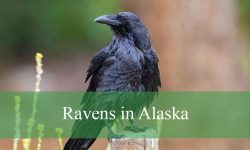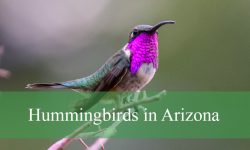Hawaii is home to some of the most unique and fascinating bird species in the world. With its tropical climate, lush forests, and remote island geography, the Aloha State has become a haven for both native and introduced birds. Whether you’re hiking through a rainforest or strolling through a city park, you’re likely to encounter a wide variety of birds in Hawaii.
From vibrant honeycreepers found only in the Hawaiian Islands to striking seabirds soaring over the Pacific, the birds of Hawaii offer a colorful and diverse experience for birdwatchers and nature lovers alike. Many of these species are not found anywhere else on Earth, making Hawaii a dream destination for spotting rare and beautiful birds.
In this guide, we’ll explore 50 of the most popular birds in Hawaii, complete with pictures and key identification tips. Whether you’re a beginner birder or a seasoned wildlife enthusiast, this list will help you recognize and appreciate the incredible avian life that makes Hawaii so special.
Different Types of Birds of Hawaii
Common Myna (Acridotheres tristis)
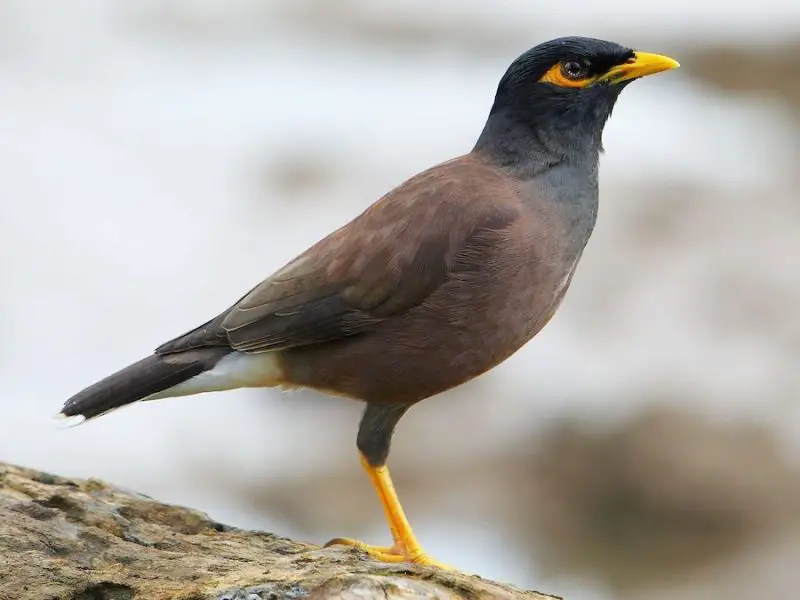
The Common Myna is a medium-sized bird with chocolate-brown feathers, a glossy black head and neck, and a distinctive patch of bright yellow skin around its eyes and beak. It also has strong yellow legs and white patches on its wings that are visible in flight. Known for its bold behavior and adaptability, this species is easy to spot in Hawaii.
These birds are extremely vocal and often produce a variety of calls, squawks, whistles, and mimicry sounds. They are highly intelligent and social, often seen in pairs or small groups, walking confidently on streets or hopping around picnic tables in search of food. Unlike many birds, they tend to walk rather than hop.
Common Mynas are widespread throughout urban and suburban areas in Hawaii. They thrive in developed spaces such as city centers, shopping areas, parks, and residential neighborhoods. Their opportunistic feeding habits and ability to nest in man-made structures have allowed them to become one of the most familiar birds across the islands.
Japanese White-eye (Zosterops japonicus)

The Japanese White-eye is a small bird with olive-green plumage and a prominent white ring around each eye, giving it a wide-eyed appearance. It has a slender, slightly curved bill, which is ideal for feeding on nectar, fruits, and small insects. With its agile flight and energetic behavior, it is often seen darting among foliage.
These birds are very active and typically travel in flocks, chattering softly as they forage among tree branches and flowering shrubs. Their high-pitched calls and constant movement make them noticeable even in dense vegetation. Though small, they play a big role in local ecosystems by pollinating plants and dispersing seeds.
In Hawaii, the Japanese White-eye is one of the most abundant bird species. It can be found in a wide range of environments, from native rainforests to suburban yards and city parks. Their adaptability and generalist diet have allowed them to thrive across all the major islands.
Zebra Dove (Geopelia striata)
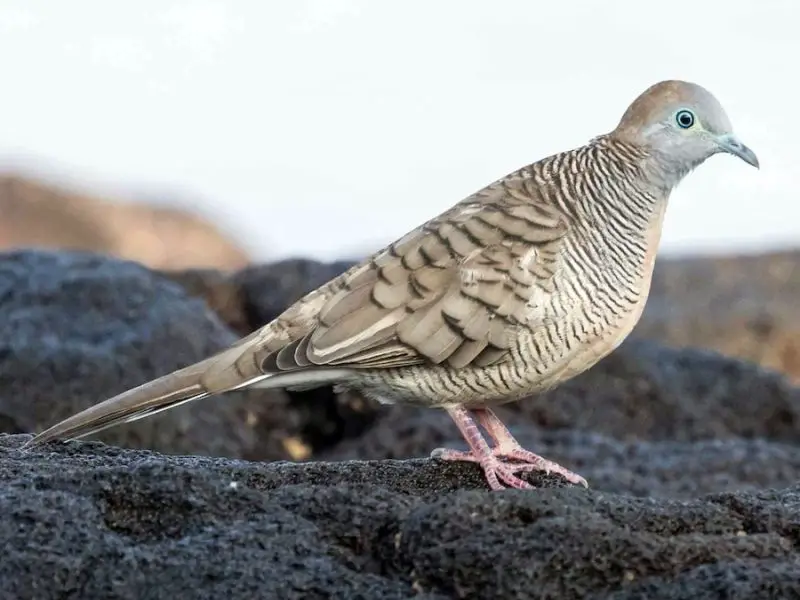
The Zebra Dove is a small, slender dove with soft brownish-gray feathers and black-and-white barring across the neck, chest, and wings that resemble zebra stripes. Its delicate appearance is further enhanced by pale blue skin around the eyes and beak. This gentle bird is commonly seen on the ground in open areas.
Its soft, melodious cooing is often heard during early mornings and is a familiar background sound in many Hawaiian neighborhoods. Zebra Doves are ground feeders, frequently observed walking calmly along sidewalks, driveways, and garden paths while pecking for seeds and crumbs.
They are extremely common in Hawaii’s cities, towns, and rural areas. You’ll often see them in yards, near cafes, or under picnic tables. They nest in shrubs, trees, and even on building ledges, showing a high tolerance for living close to humans.
Red-crested Cardinal (Paroaria coronata)
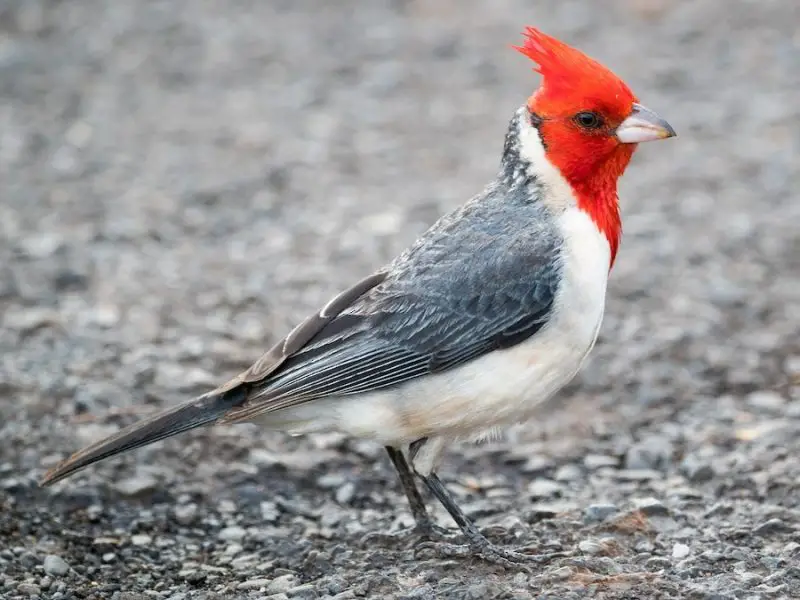
The Red-crested Cardinal is an eye-catching bird with a bright red head, pointed crest, and throat that contrast with its gray back and white belly. Though it resembles a true cardinal, it is actually part of the tanager family. Its vibrant colors and upright stance make it easily recognizable across the islands.
This species is often found foraging on the ground or perched on fences, tree limbs, and rooftops. It has a calm, pleasant whistling call and tends to move in pairs or small family groups. The prominent crest and bold facial coloration make it a favorite among birdwatchers.
Red-crested Cardinals were introduced to Hawaii from South America in the 1930s and have since become well established. They are particularly common on Oʻahu and are often found in parks, gardens, open woodlands, and near coastal areas where they have adapted well to the local environment.
House Finch (Haemorhous mexicanus)

The House Finch is a small bird with a stout body and a short, thick bill that is perfectly suited for eating seeds. Males are easily identified by their bright red foreheads, throats, and chests, while females are more muted in appearance with brown-streaked plumage. The male’s red coloration can vary depending on its diet.
These birds are highly sociable and often seen in pairs or small groups. They are common visitors to bird feeders and fruiting trees, and their pleasant, warbling songs are a familiar sound in many Hawaiian neighborhoods. During the breeding season, males sing from high perches to attract mates and defend territories.
House Finches are well adapted to urban and suburban life in Hawaii. They nest on buildings, in hanging plants, and among tree branches. You’ll frequently see them in yards, parks, and open fields, especially where food and shelter are plentiful.
Northern Cardinal (Cardinalis cardinalis)
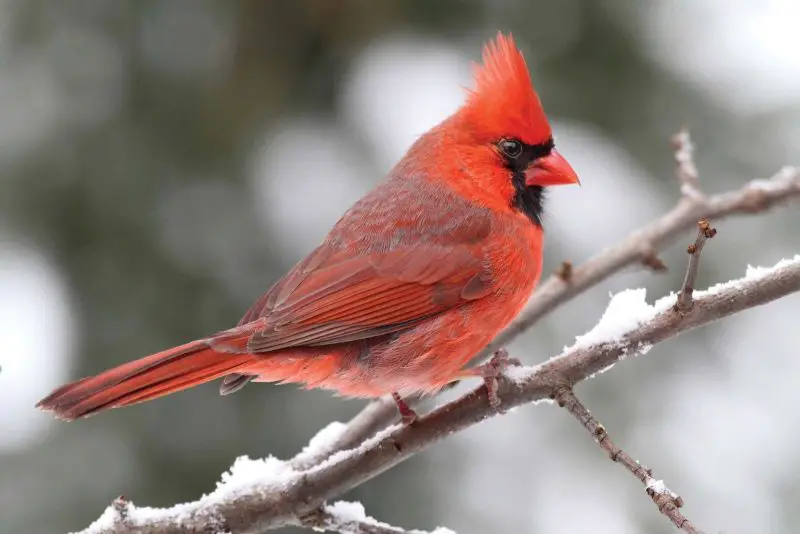
The Northern Cardinal is a striking bird, especially the male, which has brilliant red plumage and a black mask around its face. Females are more subtly colored in warm brown tones with red tinges on the wings and crest. Both sexes have a tall crest and a thick, cone-shaped orange beak that stands out clearly.
Cardinals are well known for their beautiful whistling songs, which are used for communication and marking territory. Unlike many songbirds, both males and females sing. These birds are typically seen alone or in pairs, often hopping through dense shrubs or singing from open perches.
In Hawaii, Northern Cardinals are found in gardens, forest edges, and residential areas. They prefer locations with thick vegetation where they can nest and hide, but they also visit feeders and are not shy around humans. Their vivid coloring and melodic voices make them a beloved part of the Hawaiian bird community.
Java Sparrow (Padda oryzivora)
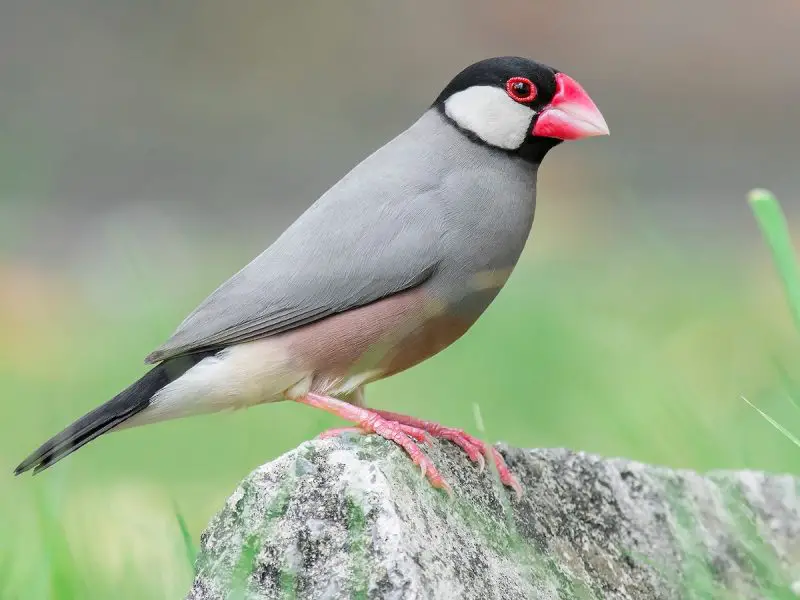
The Java Sparrow is a plump, finch-like bird known for its soft gray body, black head, pinkish belly, and large, rosy-pink bill. Its distinctive white cheeks and bright eye-ring give it a charming and easily recognizable appearance. Despite its name, it is actually a type of finch, not a true sparrow.
These birds are highly social and often seen in small flocks, especially around grassy fields and urban parks. They emit gentle chirps and enjoy perching on fences, wires, and tree branches. Their strong beaks make them adept at cracking seeds, especially rice and grains, which earned them the nickname “ricebird.”
In Hawaii, Java Sparrows are commonly found in suburban neighborhoods, city parks, and open fields near agricultural areas. They have adapted well to human environments and are especially visible during early morning and late afternoon when they gather in groups to feed and roost.
Spotted Dove (Spilopelia chinensis)
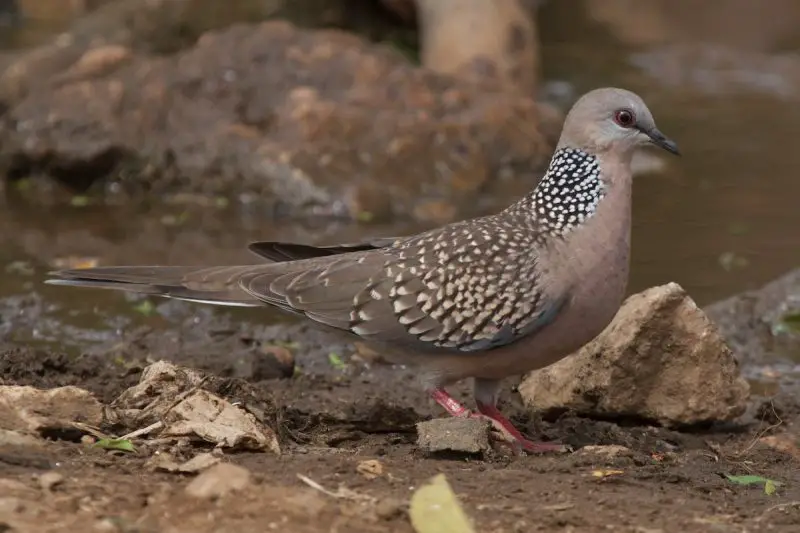
The Spotted Dove is a graceful, medium-sized dove with a soft brownish-gray body and distinctive black patch with white spots on the sides of its neck. Its wings and back have a scaly pattern, and its long tail ends in white-tipped feathers. The bird’s gentle appearance is matched by its calm demeanor.
It is known for its soft, low cooing sound, which often echoes in the early morning hours. Spotted Doves are usually seen walking on the ground in pairs or small groups, searching for seeds and grains. They are not shy and often tolerate close proximity to people.
This species is widespread throughout Hawaii and is especially common in urban and suburban areas. You’ll often find them foraging in yards, parks, and roadside grassy areas. Their ability to thrive in developed habitats has made them one of the most recognizable doves across the islands.
Rock Pigeon (Columba livia)

The Rock Pigeon is a familiar sight in cities around the world, and Hawaii is no exception. These birds come in a variety of color patterns, but most have bluish-gray feathers with two black wing bars, iridescent neck feathers, and red or orange eyes. Their compact bodies and swift flight make them easy to spot in urban settings.
They are highly adaptable and often seen gathering in large flocks in plazas, parking lots, and building ledges. Rock Pigeons are known for their strong homing instincts and have a long history of association with humans, even being used historically as messenger birds.
In Hawaii, they are ubiquitous in city centers, beaches, parks, and food courts, often scavenging for scraps. They nest on buildings, under bridges, and in abandoned structures, using minimal materials. Despite their reputation as “city birds,” they play a role in urban ecosystems and remain a constant presence in daily island life.
Yellow-billed Cardinal (Paroaria capitata)

The Yellow-billed Cardinal is a striking bird with a brilliant red head, contrasting with a white chest and black back. Its most distinguishing feature is its bright yellow beak, which sets it apart from the similar Red-crested Cardinal. Its elegant, sharp features and bold coloring make it easy to recognize.
These cardinals often forage on the ground in small groups and can be quite tame around humans. They have soft, melodious calls and tend to stay close to low vegetation or open lawns. Their social nature and attractive looks have made them popular among birdwatchers and locals alike.
Yellow-billed Cardinals are especially common on the Big Island of Hawaii, where they thrive in open areas like parks, gardens, and pasturelands. Introduced from South America, they have adapted well to island habitats and are now a beloved part of the Big Island’s bird population.
Red-vented Bulbul (Pycnonotus cafer)
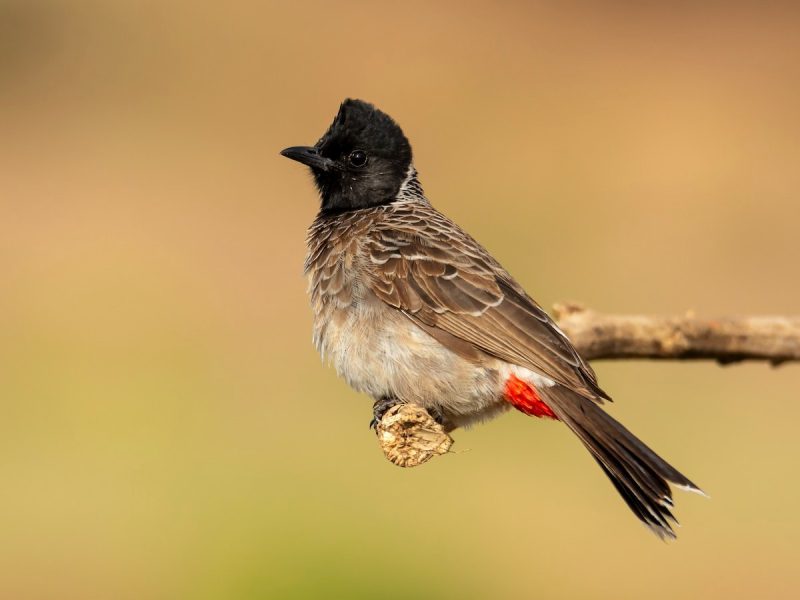
The Red-vented Bulbul is a medium-sized songbird with a dark brown body, a slightly crested black head, and a vivid red patch under the tail, which gives the species its name. Its underparts are lighter and finely streaked, and it has a short, slightly down-curved bill ideal for feeding on fruits and insects.
These birds are active, vocal, and often perch in prominent spots while making bubbly or chattering calls. They are known to be quite bold, even aggressive at times, and can be seen chasing other birds away from food sources. Their diet includes berries, flowers, nectar, and small insects.
In Hawaii, the Red-vented Bulbul is widespread in urban and suburban areas, especially on Oʻahu. They frequent gardens, parks, and street trees. However, they are considered invasive due to their impact on agriculture and competition with native bird species, so efforts to control their spread are ongoing.
Warbling White-eye (Zosterops japonicus)
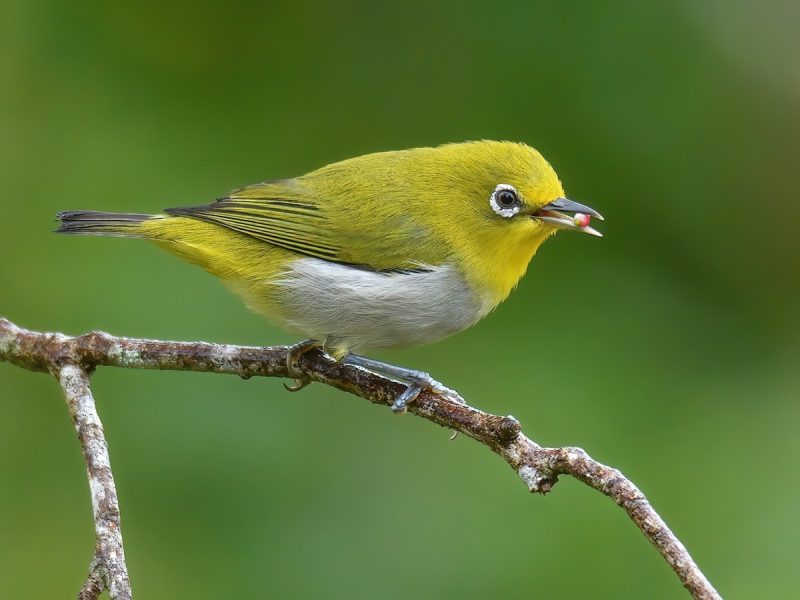
The Warbling White-eye, also known as the Japanese White-eye, is a small, energetic bird with olive-green upperparts, yellow throat and chest, and a distinct white ring around the eyes. This white eye-ring gives the bird its name and a unique, almost cartoonish appearance.
These birds are incredibly agile and often flit quickly through trees and shrubs in search of insects, nectar, and fruits. Their soft, warbling calls can be heard throughout the day, especially in forested areas and gardens. They often form active flocks that move together while foraging.
In Hawaii, the Warbling White-eye is one of the most common and widespread birds. It can be found from mountain forests to residential neighborhoods. Its adaptability and generalist feeding habits have helped it become a dominant presence across the islands, though it has also raised concerns for its competition with native bird species.
Common Waxbill (Estrilda astrild)
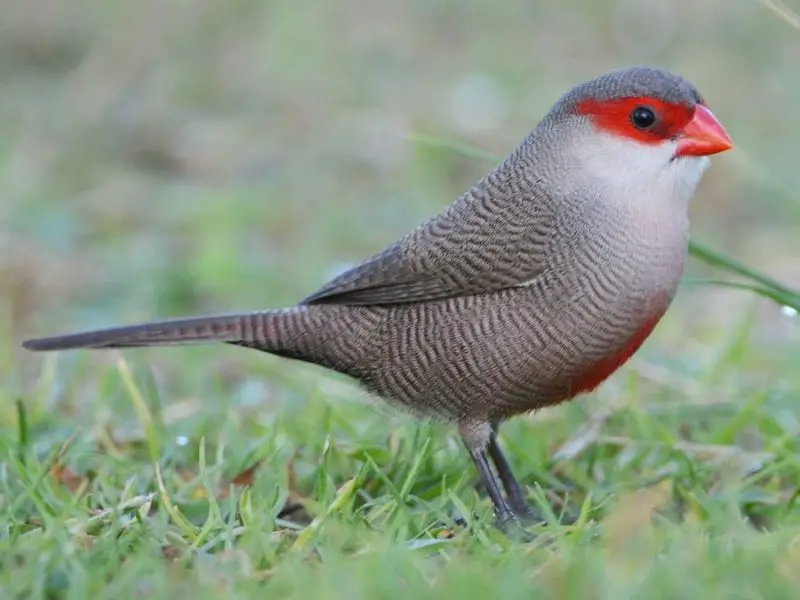
The Common Waxbill is a petite, slender bird with grayish body feathers, a bright red beak, and a distinct red stripe running from the beak through the eye. Its fine barring across the chest and flanks gives it a delicate, textured appearance. Males and females look quite similar, making them a charming sight in grasslands.
These birds are highly social and often found in small flocks, foraging for seeds among tall grasses and weedy fields. Their high-pitched calls are soft and almost whisper-like, but they communicate constantly as they feed or move together. During flight, they appear agile and fluttery.
In Hawaii, Common Waxbills are widespread in grassy open areas, such as fields, parks, and roadside meadows. They thrive in lowland regions where there is ample cover and seed availability. Their adaptability and quiet beauty make them a pleasant, if subtle, part of the local avifauna.
Chestnut Munia (Lonchura atricapilla)
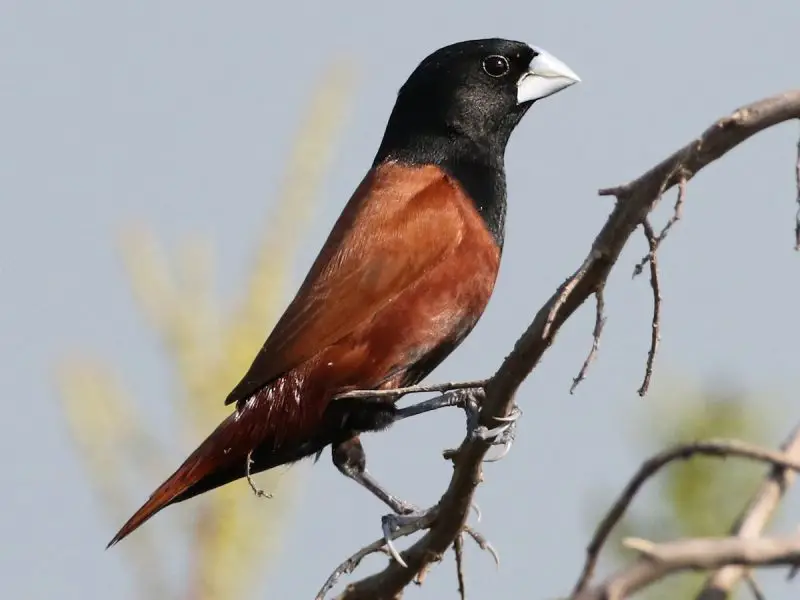
The Chestnut Munia is a small, stocky finch with rich chestnut-brown plumage and a glossy black head. Its bill is thick and pale bluish-gray, suited for cracking tough seeds. Sometimes called the Black-headed Munia, it is easily distinguished by its striking color contrast and smooth feathers.
These birds are often observed in pairs or flocks, especially near rice fields, grasslands, and water edges. They forage primarily on grass seeds and grains and are known for their gentle, rhythmic calls. During breeding season, they construct neat, dome-shaped nests using grass and leaves.
In Hawaii, the Chestnut Munia is frequently found in grassy habitats across the islands, including urban edges and agricultural areas. Introduced originally from Asia, it has settled comfortably into open landscapes, contributing to the diversity of small, seed-eating birds in Hawaii.
Nutmeg Mannikin (Lonchura punctulata)

The Nutmeg Mannikin, also known as the Scaly-breasted Munia, is a small, brown bird named for the scale-like markings on its breast and flanks. It has a dark brown back, a lighter belly with white scalloped feathers, and a thick gray beak built for seed consumption.
These birds are gregarious and usually move in small groups or loose flocks. They prefer areas with tall grasses where they can find seeds and shelter. Their vocalizations are soft and rapid, often heard when they’re feeding or flying in tight formations from one patch of grassland to another.
In Hawaii, Nutmeg Mannikins are widespread in open grassy habitats, particularly in lowland fields, park edges, and suburban gardens. Their ability to blend into grassy surroundings and forage efficiently makes them a resilient and common part of the island bird community.
African Silverbill (Euodice cantans)
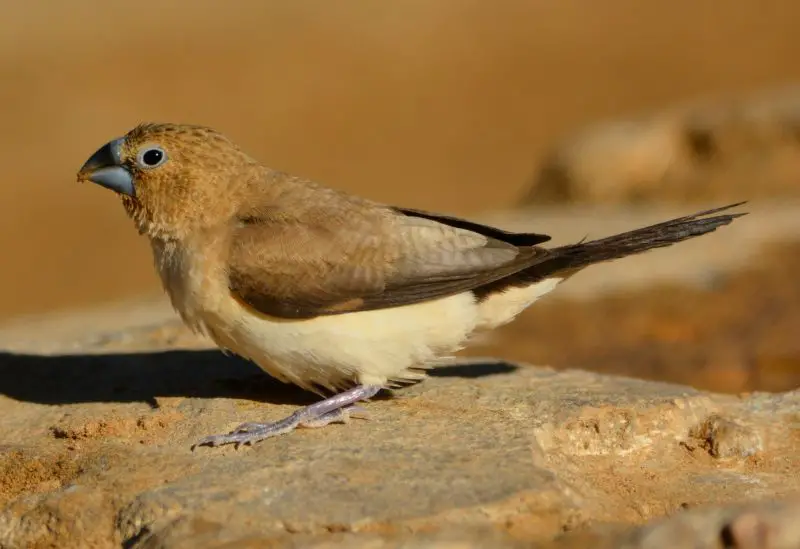
The African Silverbill is a small finch with pale brown upperparts, lighter underparts, and a distinctive silver-gray bill. It has a slightly rounded head and short tail, giving it a compact and dainty profile. A fine dark line behind the eye adds subtle detail to its face.
These birds are quiet and social, often seen in pairs or small groups as they forage for tiny seeds. Their soft twittering calls and peaceful behavior make them a pleasant presence in dry open areas. During breeding, they nest in shrubs or crevices, sometimes reusing old nests of other birds.
In Hawaii, the African Silverbill is mostly found in dry, arid environments such as scrublands, open fields, and dry coastal plains. Though not as flashy as some other finches, their calm demeanor and adaptability have helped them establish a stable presence in Hawaii’s warmer, drier habitats.
Yellow-fronted Canary (Serinus mozambicus)
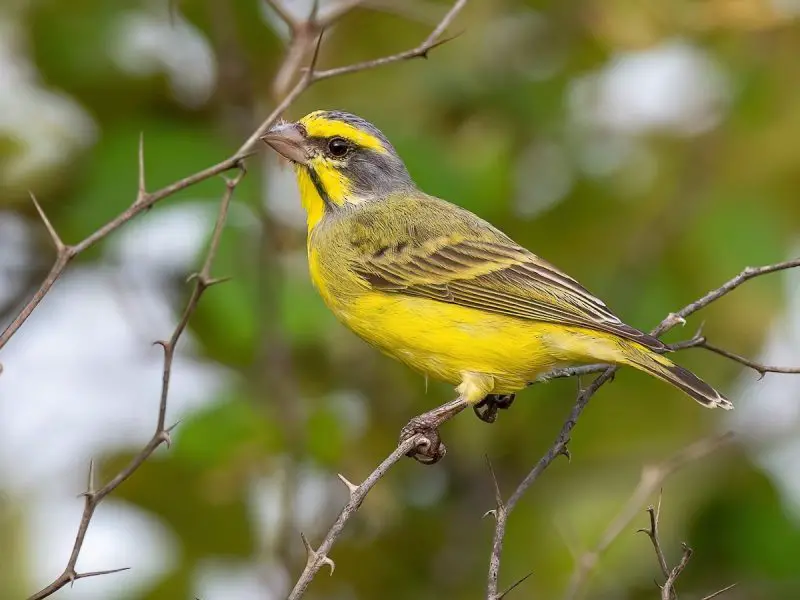
The Yellow-fronted Canary is a lively little songbird with bright yellow underparts and a vibrant yellow forehead and face, which contrast with its olive-gray back and wings. Its cheerful expression and distinctive coloration make it a favorite among birdwatchers and locals.
This species is known for its melodic, tinkling song that includes whistles and trills, often delivered from an open perch. Yellow-fronted Canaries are typically seen alone or in pairs, hopping around grassy areas or low shrubs in search of seeds. They are alert and quick-moving, with an agile flight pattern.
In Hawaii, they are most often found in grassy clearings, farmland edges, and dry open woodlands. Though originally native to sub-Saharan Africa, they have adapted well to the Hawaiian landscape and are now part of the islands’ diverse mix of small finch-like birds.
Northern Mockingbird (Mimus polyglottos)
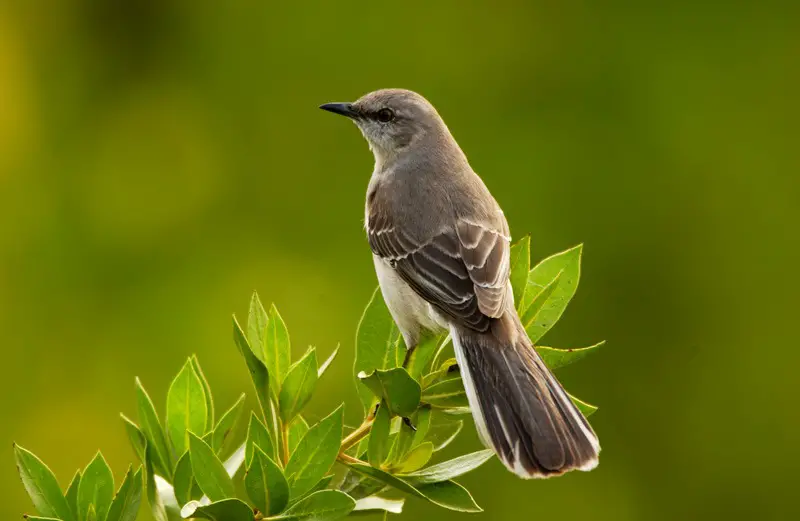
The Northern Mockingbird is a medium-sized gray bird with a long tail, white wing patches, and a slender bill. It has a sleek appearance and sharp eyes, and is well known for its intelligence and bold behavior. The white flashes in its wings become most visible during flight or displays.
This bird is famous for its ability to mimic the songs of many other bird species, as well as artificial sounds like car alarms and cell phone tones. Males sing endlessly during breeding season, often perched high on trees or rooftops. Their mimicry serves both territorial and courtship purposes.
In Hawaii, Northern Mockingbirds are often found in urban and suburban areas, where they adapt easily to lawns, gardens, and city parks. They are confident and territorial, often seen chasing away larger birds. Their energetic presence and musical variety make them one of the more charismatic songbirds across the islands.
White-rumped Shama (Copsychus malabaricus)

The White-rumped Shama is a striking songbird known for its glossy black plumage, bright chestnut belly, and prominent white rump, which is visible during flight. It has a long, graceful tail and slender frame, giving it an elegant appearance in the forest understory.
This species is highly regarded for its melodious and complex songs. Males sing often, especially at dawn, with a variety of whistles, trills, and mimicry. They are territorial and usually stay hidden within dense foliage, darting quickly between branches or hopping along the ground.
In Hawaii, White-rumped Shamas are most commonly found in forested areas, particularly in shady, humid valleys and upland woods. Originally introduced from Asia, they have become a familiar sound in Hawaiian forests, appreciated by bird enthusiasts for their beautiful vocalizations.
Red-billed Leiothrix (Leiothrix lutea)

The Red-billed Leiothrix is a colorful, small bird with an olive-green back, yellow throat, and bright orange-red bill. Its wings feature flashes of red and yellow, adding to its vibrant appearance. Its subtle beauty and compact size make it a hidden gem in forest habitats.
These birds are known for their soft, melodious songs and chattering calls. They are social and often move in small flocks, foraging for insects, fruits, and nectar. During the breeding season, they build cup-shaped nests in thick shrubs, laying several small, pale eggs.
In Hawaii, the Red-billed Leiothrix thrives in mid- to high-elevation forests, especially in cooler, misty regions. Though non-native, it has established itself successfully and is often heard before being seen, as it quietly weaves through the forest understory.
ʻApapane (Himatione sanguinea)
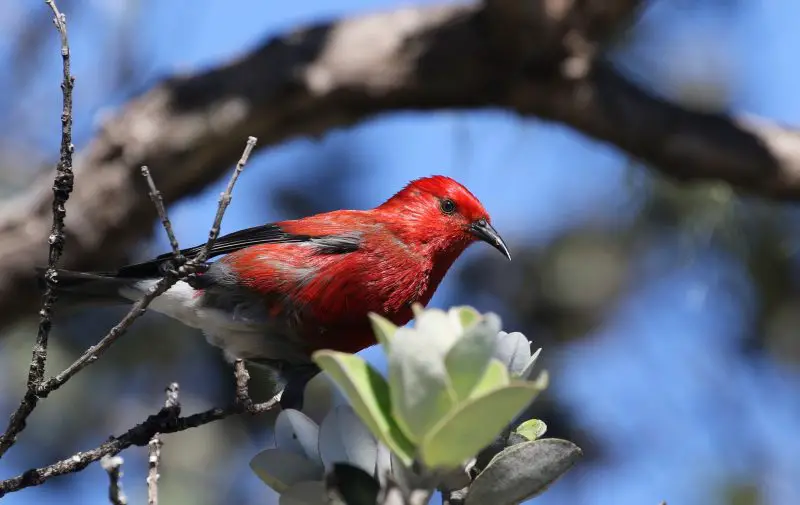
The ʻApapane is a striking honeycreeper with crimson-red plumage, contrasting black wings and tail, and a slightly curved bill suited for sipping nectar. Its eyes are dark and bright, adding to its lively expression as it flits among blossoms.
ʻApapane are energetic birds and excellent fliers, often seen darting through treetops or hovering around flowers such as ʻōhiʻa lehua. They also supplement their nectar diet with small insects and arthropods. Their high-pitched calls and sharp chirps echo through native forests.
This species is endemic to Hawaii and plays a crucial role in pollination. ʻApapane are especially abundant in native rainforests at higher elevations, where they depend on native flora. Their vivid color and constant motion make them a favorite among birdwatchers and conservationists.
ʻIʻiwi (Drepanis coccinea)
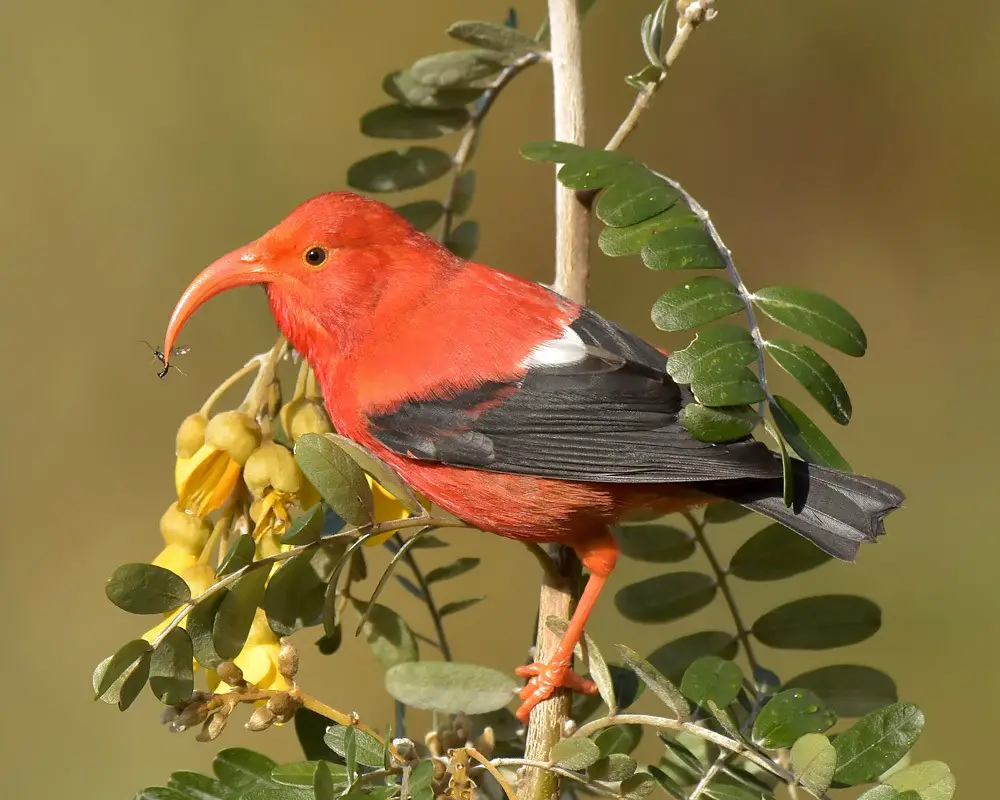
The ʻIʻiwi is one of Hawaii’s most iconic birds, recognized by its brilliant scarlet-red body, black wings, and long, down-curved orange bill. It is visually stunning and often associated with Hawaiian culture and conservation efforts.
Known for feeding on nectar from native plants like ʻōhiʻa lehua, the ʻIʻiwi uses its specialized bill to extract nectar deep within tubular flowers. Its call is a series of squeaky and raspy notes, unlike any other Hawaiian forest bird. It is agile and swift, often seen in the treetops.
Sadly, the ʻIʻiwi has declined in many areas due to habitat loss and avian diseases. It is now mostly found in higher elevation forests where mosquitoes carrying disease are less common. Conservationists work diligently to protect this symbol of Hawaii’s unique biodiversity.
Nēnē (Branta sandvicensis)

The Nēnē, or Hawaiian Goose, is Hawaii’s official state bird. It resembles a small Canada Goose but has unique features such as deeply furrowed neck feathers, reduced webbing on its feet for walking on lava fields, and a generally quieter demeanor.
This species is herbivorous, feeding on grasses, leaves, and berries. Nēnē are monogamous and nest on the ground, often choosing remote or protected areas for breeding. Their soft honks and gentle behavior make them a calm presence in open landscapes.
Native and endemic to Hawaii, the Nēnē is most commonly seen in protected habitats on Maui, Kauaʻi, and the Big Island. After near-extinction in the 1950s, conservation efforts have helped their population rebound, although they remain vulnerable and under continued protection.
ʻAmakihi (Chlorodrepanis virens)
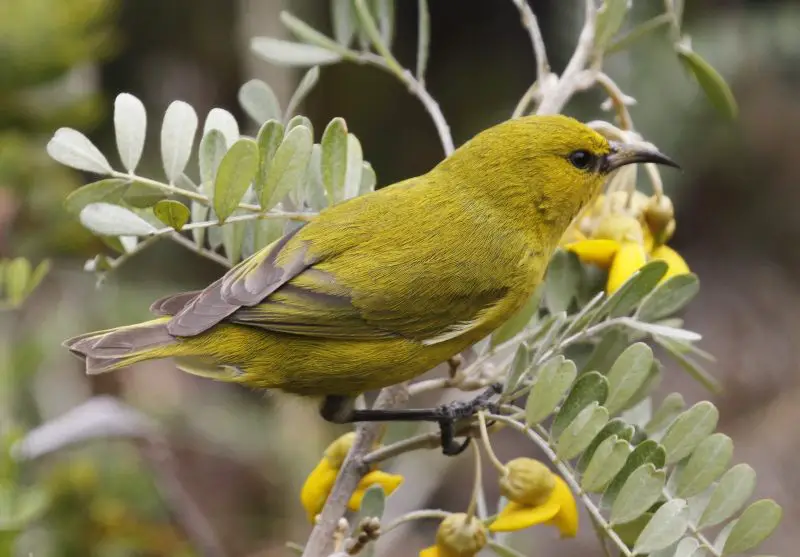
The ʻAmakihi is a small, bright green honeycreeper with a slightly curved black bill and subtle yellowish underparts. Its plumage blends well with the leaves of the forest canopy, making it more often heard than seen.
Highly adaptable, the ʻAmakihi feeds on nectar, insects, and tree sap. Its call is a rapid series of high-pitched notes, often heard throughout the day. Unlike many other native birds, the ʻAmakihi has shown resilience against avian malaria and other diseases.
Found in a wide range of forested environments, from dry lowland woods to high-elevation rainforests, this native species remains relatively common in comparison to other Hawaiian honeycreepers. It serves as a symbol of hope for native bird conservation.
ʻAlalā (Corvus hawaiiensis)
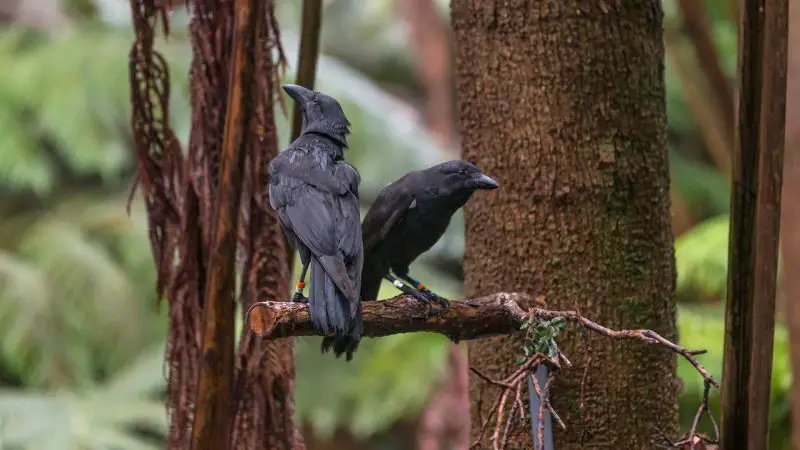
The ʻAlalā, or Hawaiian Crow, is a large, intelligent bird with all-black plumage and a stout bill. It possesses strong vocal abilities, capable of a variety of calls, from raspy croaks to softer whistles. Its expressive eyes and inquisitive behavior are characteristic of the corvid family.
Once extinct in the wild, the ʻAlalā has been the focus of extensive conservation and breeding efforts. After more than two decades in captivity, birds have been carefully reintroduced into native forests on Hawaiʻi Island. Their return marks a significant achievement in Hawaiian wildlife restoration.
ʻAlalā are forest dwellers, previously common in upland koa and ʻōhiʻa forests. They play an important ecological role as seed dispersers. Today, they inhabit protected areas where conservation teams monitor their behavior, helping to ensure their survival in the wild.
ʻAlae ʻula (Gallinula galeata sandvicensis)
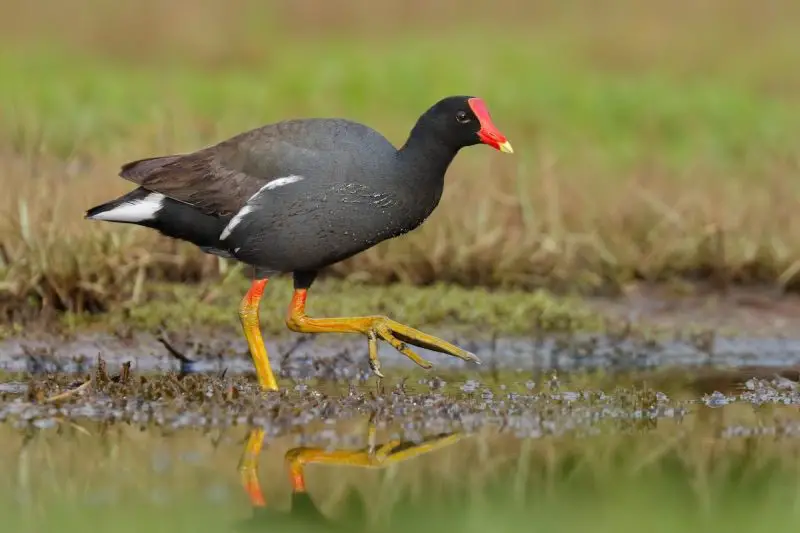
The ʻAlae ʻula, or Hawaiian Gallinule, is a sleek black waterbird with a striking red frontal shield and yellow-tipped beak. It has long legs and large feet that allow it to walk gracefully on floating vegetation and through dense wetlands.
This species is known for its secretive behavior and preference for quiet, vegetated marshes. It forages for plant matter, seeds, insects, and aquatic animals. During nesting season, pairs become highly territorial and build nests hidden in reeds or grasses.
Found on Oʻahu and Kauaʻi, the ʻAlae ʻula is a subspecies endemic to Hawaii and listed as endangered. It relies on healthy wetland ecosystems for survival, and conservation programs focus on habitat protection and predator control to support its population.
ʻAkiapōlāʻau (Hemignathus wilsoni)
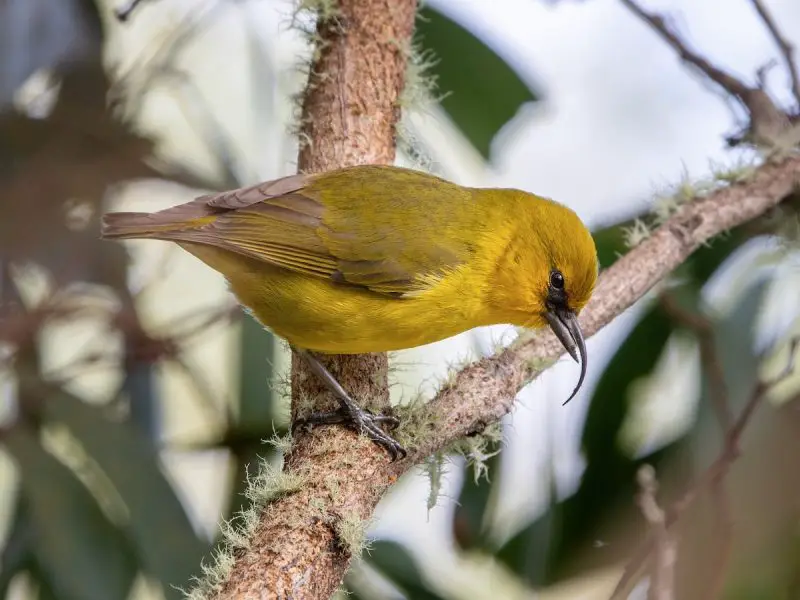
The ʻAkiapōlāʻau is a rare Hawaiian honeycreeper known for its uniquely curved bill, with a long, slender upper mandible and shorter, stout lower mandible. It uses this specialized tool to probe tree bark for insects and sap, resembling both a woodpecker and a hummingbird in behavior.
This bird is primarily insectivorous, relying heavily on larvae and beetles hidden within tree trunks. Males sing a trilling, warbling song that echoes through native forests, especially during the breeding season. The species is elusive and usually found alone or in pairs.
Endemic to the Big Island of Hawaiʻi, the ʻAkiapōlāʻau is critically endangered and found only in remote high-elevation forests with old-growth koa and ʻōhiʻa trees. Conservation efforts target habitat restoration and protection from invasive species to ensure its survival.
ʻAkekeʻe (Loxops caeruleirostris)
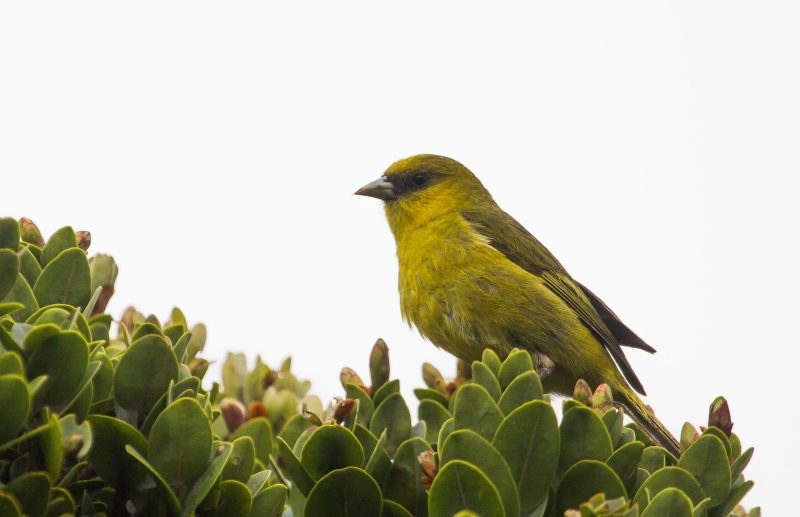
The ʻAkekeʻe is a small, active honeycreeper with pale green and yellow plumage and a distinctive crossed bill. Males often appear slightly more yellow, while females are greener. Its unique bill is used to pry open buds and leaves in search of insects and nectar.
These birds are most vocal in the early morning, with high-pitched whistles and squeaks. They forage quickly among the upper canopy, often seen in small flocks or mixed-species groups. Their diet includes spiders, caterpillars, and nectar from native blossoms.
The ʻAkekeʻe is endemic to the island of Kauaʻi and lives exclusively in the island’s high-elevation native forests. It is critically endangered, primarily due to habitat loss, disease, and the impact of invasive species. Conservation programs focus on preserving its shrinking habitat.
ʻAkepa (Loxops coccineus)
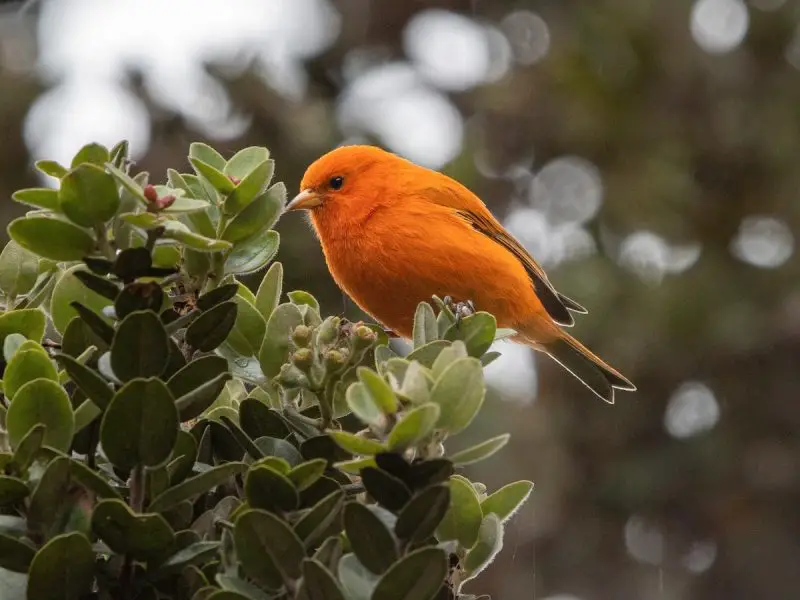
The ʻAkepa is a small, brightly colored honeycreeper found only on the Big Island. Males are a vivid orange-red, while females are duller yellowish-green. It has a slightly notched tail and a delicate, slightly curved bill adapted for feeding on nectar and insects.
Shy and often quiet, the ʻAkepa flits through the canopy in search of food. It is one of the few Hawaiian birds known to use natural tree cavities for nesting, usually in old koa trees. During the breeding season, males sing soft, tinkling notes to attract mates.
This species resides in high-elevation ʻōhiʻa and koa forests on Hawaiʻi Island. Though once more widespread, the ʻAkepa has declined due to habitat degradation and disease. It is currently considered endangered and is a high priority for habitat preservation and monitoring.
Palila (Loxioides bailleui)

The Palila is a large, finch-like honeycreeper with a distinctive yellow head, white underparts, and a gray back. It has a heavy, parrot-like bill adapted for cracking seeds, particularly those of the mamane tree, which forms the core of its diet.
Palila are often seen perched in mamane trees, foraging for seed pods, flowers, and occasionally insects. They have a sweet, flutelike song and are typically found in pairs or small groups. Their specialized feeding behavior ties them closely to their native plant environment.
Endemic to the upper slopes of Mauna Kea on Hawaiʻi Island, the Palila inhabits dry montane forests where mamane trees are abundant. Due to its restricted range and dependence on a single tree species, it is critically endangered, with conservation efforts centered on protecting its unique habitat.
ʻAnianiau (Magumma parva)
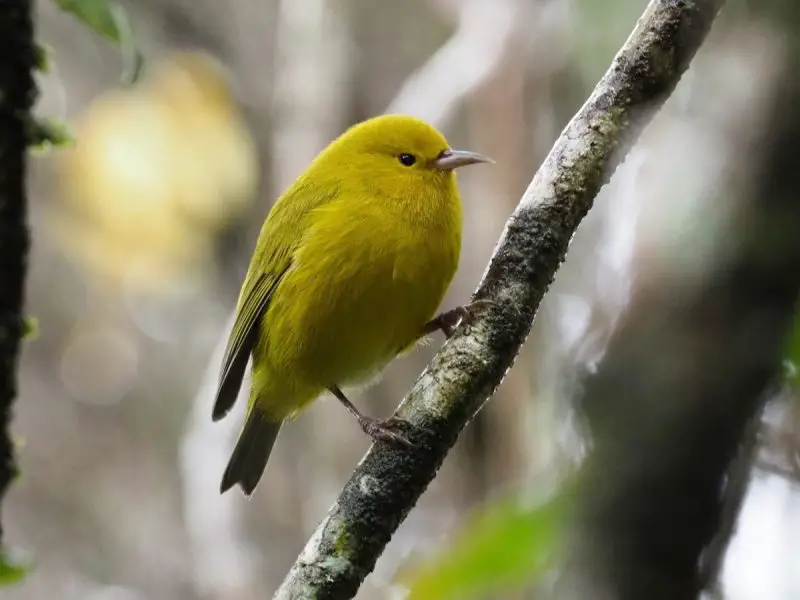
The ʻAnianiau is the smallest native Hawaiian honeycreeper, easily recognized by its vibrant yellow plumage. With a short, slightly curved bill, it flits rapidly among blossoms in search of nectar. Males are typically brighter than females, and their size—only about 4 inches—makes them quite delicate in appearance.
This species is highly active, constantly moving through the canopy as it feeds on nectar from native flowers like ʻōhiʻa lehua. In addition to nectar, it also consumes insects, especially during breeding season when protein is needed for chicks. Its song is a soft, high-pitched trill.
Endemic to the island of Kauaʻi, the ʻAnianiau is now confined to high-elevation native forests in the Alakaʻi Plateau. Although less threatened than some other native birds, it still faces risks from habitat loss, invasive species, and mosquito-borne diseases.
ʻOmaʻo (Myadestes obscurus)

The ʻOmaʻo is a native Hawaiian thrush found only on Hawaiʻi Island. This medium-sized bird has gray-brown plumage, a white belly, and large, expressive eyes. Despite its plain appearance, it is known for its beautiful and complex song, often heard echoing through misty forests.
This species plays a vital ecological role as a seed disperser. It feeds on native fruits, berries, and occasionally insects, helping to maintain healthy forest regeneration. ʻOmaʻo are often shy and solitary, staying well hidden in dense understory vegetation.
Today, the ʻOmaʻo is found in mid- to high-elevation rainforests, especially in protected areas like Hakalau Forest National Wildlife Refuge. It is considered one of the more stable native birds but remains vulnerable to introduced predators and habitat degradation.
Puaiohi (Myadestes palmeri)

The Puaiohi is a critically endangered thrush, endemic to the island of Kauaʻi. It has a gray-brown back, a pale belly, and a distinctive eye-ring. Though not colorful, it is known for its sweet, melodic song that fills the remote Alakaʻi wilderness where it survives.
This elusive bird feeds primarily on native fruits, but also eats insects and small invertebrates. It nests in steep, mossy ravines near streams, where it lays just a few eggs each season. Its limited breeding range and small population make it particularly susceptible to environmental change.
The Puaiohi is now restricted to the upper reaches of the Alakaʻi Plateau. Conservation efforts include predator control, captive breeding, and habitat restoration. Despite its rarity, focused recovery actions offer hope for its continued survival.
ʻElepaio (Chasiempis spp.)

The ʻElepaio is a small monarch flycatcher with three distinct subspecies, each found on a different island: Hawaiʻi, Oʻahu, and Kauaʻi. It has a curious and energetic personality, often seen flitting among branches and flicking its tail. Plumage varies by subspecies, but generally includes shades of brown, white, and gray.
ʻElepaio are insectivores and spend much of their time gleaning bugs from bark or leaves. They are one of the first native birds to vocalize at dawn, singing a loud, sharp call. This bird is also culturally significant in Hawaiian tradition, once considered a guide for canoe builders.
The different subspecies have adapted to various forest environments. The Kauaʻi ʻElepaio is endangered, while the Oʻahu form is near extinction. The Hawaiʻi Island subspecies remains more stable but still faces challenges from habitat loss and mosquito-borne disease.
ʻOʻu (Psittirostra psittacea)
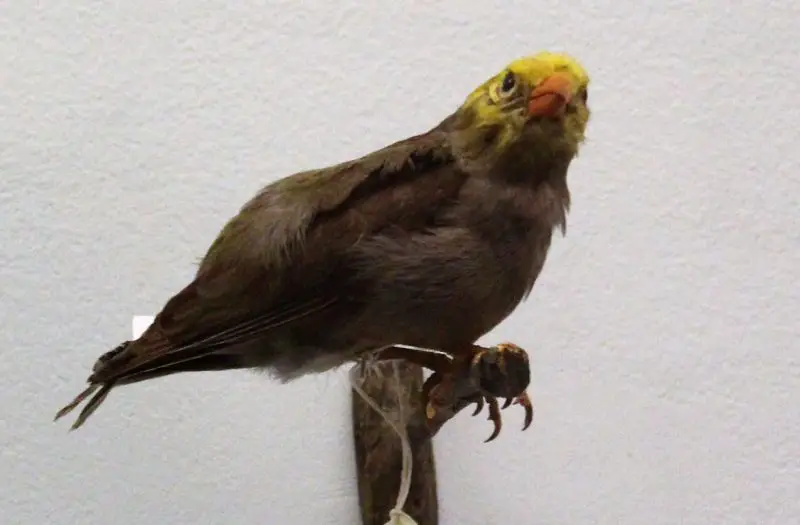
The ʻOʻu was a plump, greenish-yellow honeycreeper with a parrot-like beak, adapted for eating fruits and tender plant shoots. Its large head and short tail gave it a distinctive appearance among native forest birds. It once ranged across multiple Hawaiian Islands.
Highly nomadic, the ʻOʻu moved with seasonal food availability, traveling between islands and elevations. It was particularly fond of native fruits like ieie and ʻōhelo. Its movements and diet made it an important seed disperser in ancient Hawaiian forests.
Sadly, the ʻOʻu has not been seen in the wild since the 1980s and is likely extinct. Its decline is linked to habitat loss, disease, and predation by introduced species. Though unconfirmed sightings keep hope alive, it remains one of Hawaii’s most enigmatic lost birds.
Laysan Albatross (Phoebastria immutabilis)
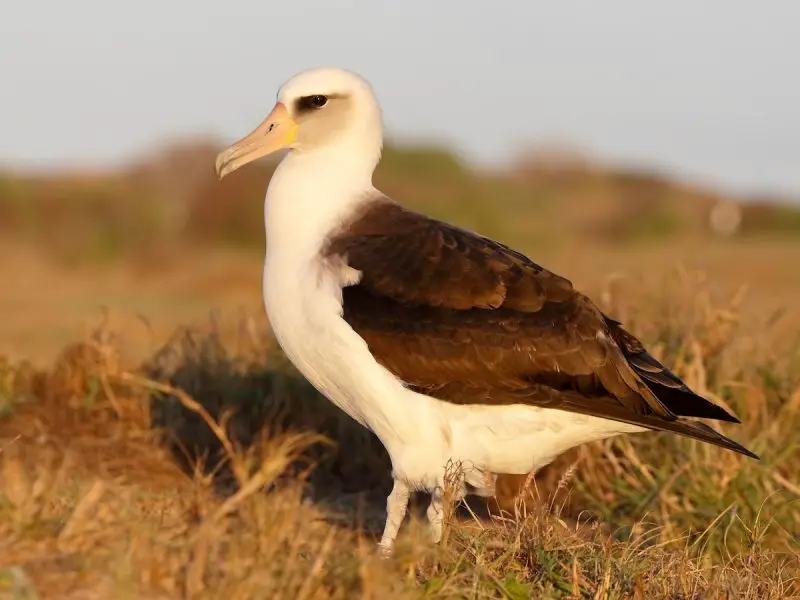
The Laysan Albatross is a large seabird with striking white and gray plumage, long wings, and a pinkish bill. It has a distinctive black eye ring and an impressive wingspan of over six feet, allowing it to soar effortlessly across the ocean for hours without flapping.
These birds are highly loyal, returning each year to the same nesting site—mainly on the Northwestern Hawaiian Islands like Midway Atoll and Laysan Island. During breeding season, they perform elaborate courtship dances. They lay a single egg and both parents care for the chick.
While most of the population breeds on remote atolls, Laysan Albatrosses are occasionally seen flying near the main Hawaiian Islands. At sea, they feed on squid, fish, and other marine organisms. Though considered near-threatened due to plastic ingestion and bycatch, their numbers are relatively stable thanks to conservation efforts on protected islands.
Black Noddy (Anous minutus)

The Black Noddy is a sleek seabird known for its dark plumage and contrasting white cap on the forehead. It has a slender body, long pointed wings, and a sharp black bill, giving it a streamlined look for efficient flight over open water. Its eyes appear large and expressive, helping it spot prey just below the ocean’s surface.
This species feeds primarily on small fish and squid, often diving or snatching food from just above the waves. Black Noddies are agile and graceful in flight, typically flying close to the water in search of feeding opportunities. Their calls are soft and chattering, often heard around nesting colonies.
They nest in large colonies on remote offshore islands, building simple nests in rocky crevices or under vegetation. In Hawaii, breeding populations are found mainly on the Northwestern Hawaiian Islands, where they are protected from predators and human disturbance.
Brown Noddy (Anous stolidus)

The Brown Noddy is larger than the Black Noddy, with chocolate-brown plumage and a pale cap that gives its face a gentle contrast. Its bill is heavier and more robust, and its body appears sturdier, well-suited to long-distance flights over the ocean.
These birds forage by skimming over the water and catching small fish and squid. They often follow schools of predatory fish or marine mammals that drive prey to the surface. Brown Noddies are social birds, frequently seen in flocks or in noisy breeding colonies.
In Hawaii, they nest on coastal cliffs, small islands, and rocky ledges. Their nests are built from sticks and vegetation and may be reused across seasons. Breeding sites are mostly located in predator-free environments on the outer islands, though some colonies exist closer to the main Hawaiian chain.
White Tern (Gygis alba)
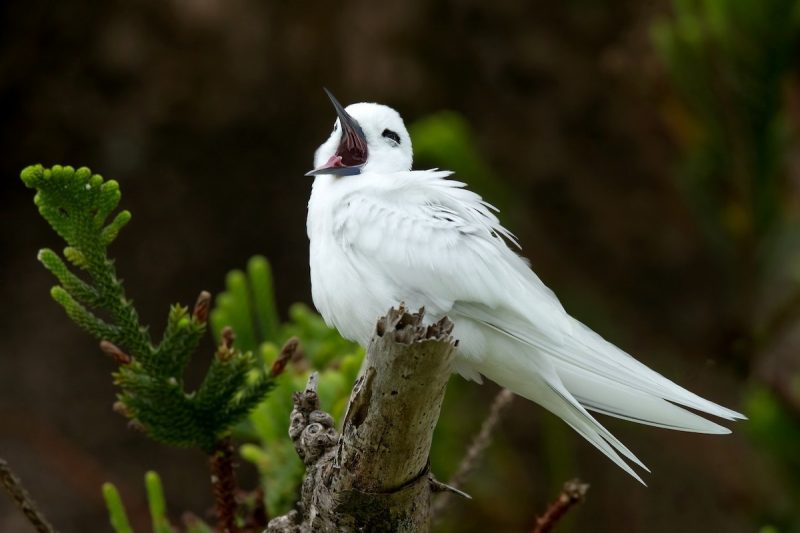
The White Tern, also known as the “Fairy Tern,” is instantly recognizable by its all-white plumage, dark eyes, and slender black bill. It has a graceful appearance with long tail streamers and elegant flight patterns. Unlike many seabirds, it lacks a true nesting structure.
Instead of building a nest, the White Tern lays a single egg directly on bare tree branches or ledges. It has developed an extraordinary ability to balance the egg, often in the forks of trees in urban settings. In Honolulu, they are especially popular and are affectionately called “Manu-o-Kū.”
These terns feed by plunge-diving for small fish and squid, usually near the coast. Their gentle demeanor and striking looks have made them a beloved presence in Hawaiian cities, especially on Oʻahu where they are protected and celebrated as official symbols.
Wedge-tailed Shearwater (Ardenna pacifica)
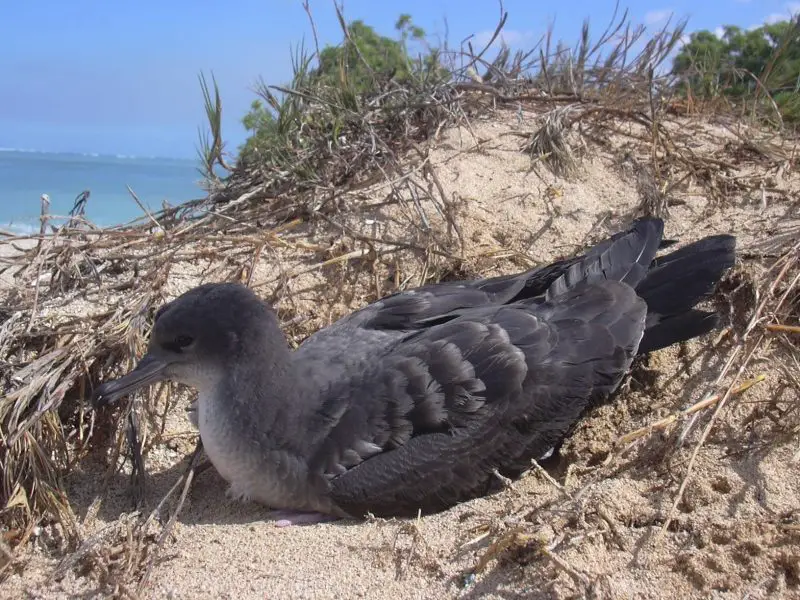
The Wedge-tailed Shearwater is a common seabird in Hawaiian waters, named for its long, tapered tail. It has dark gray upperparts and lighter underparts, with long wings that allow it to soar effortlessly just above the ocean surface. Its eerie, moaning calls are a signature of its colonies.
These birds forage far out to sea, gliding over the waves and diving for squid, fish, and crustaceans. They often travel long distances in search of food and can remain at sea for days. At night, they return to land to feed their chicks and roost in burrows.
Wedge-tailed Shearwaters breed in colonies on coastal cliffs and offshore islands. They dig burrows in sandy or rocky soil and typically return to the same site each year. Colonies can be quite noisy and active, especially during the breeding season from March to November.
Newell’s Shearwater (Puffinus newelli)

Newell’s Shearwater is a rare and endangered seabird that breeds exclusively on the island of Kauaʻi. It has black upperparts and white underparts, with a sleek body and a sharply hooked bill. This nocturnal species is rarely seen at sea during the day but is known for its swift and agile flight.
Unlike other seabirds, Newell’s Shearwaters nest in burrows or rocky crevices on steep mountain slopes. They return to land only under cover of darkness to avoid predators, guided by moonlight and their innate navigation skills. Chicks are raised in deep forested valleys far from human activity.
This species is severely threatened by habitat loss, invasive predators, and light pollution, which can disorient fledglings during their first flight to sea. Conservation programs on Kauaʻi aim to protect nesting areas and mitigate threats, but the bird remains critically endangered.
Hawaiian Petrel (Pterodroma sandwichensis)
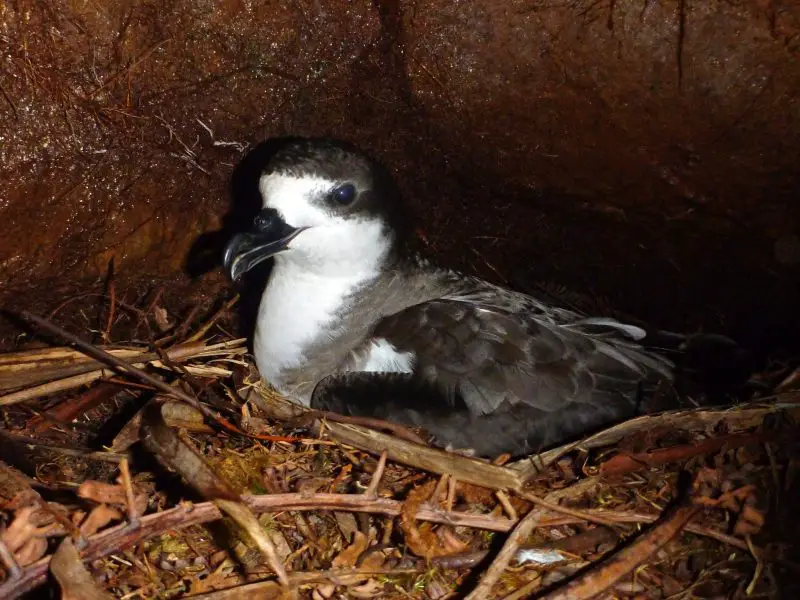
The Hawaiian Petrel is one of the world’s rarest seabirds and is found only in the Hawaiian Islands. It has dark gray plumage on the back and wings, with white underparts and a distinct black cap. Its strong, hooked bill is adapted for catching slippery marine prey.
This pelagic bird spends most of its life over the open ocean, feeding on squid, fish, and crustaceans. It returns to land only to breed, nesting in remote, high-elevation burrows. Its haunting calls can be heard echoing through the mountains at night during breeding season.
Once widespread, the Hawaiian Petrel now nests primarily on Maui, Hawaiʻi Island, and Kauaʻi. The species is highly vulnerable to introduced predators, habitat destruction, and collisions with artificial lights. Intensive recovery efforts, including predator control and burrow protection, are underway to safeguard this iconic native seabird.
Pacific Golden-Plover (Pluvialis fulva)

The Pacific Golden-Plover, locally known as “Kolea”, is a familiar sight across Hawaii during the winter months. These elegant shorebirds migrate from their breeding grounds in Alaska, arriving in the islands around late August and staying until April or May. Their sleek golden-brown feathers and distinctive posture make them easy to recognize in grassy areas and parks.
While in Hawaii, Kolea adapt surprisingly well to urban settings and are often seen in schoolyards, golf courses, and lawns. They are territorial and tend to return to the same spots year after year, which endears them to many residents who look forward to their seasonal visits.
Their diet includes insects, worms, and other invertebrates found on the ground. Despite their long journey and small size, they are strong flyers capable of nonstop flights across the Pacific, a remarkable feat for such compact birds.
Wandering Tattler (Tringa incana)
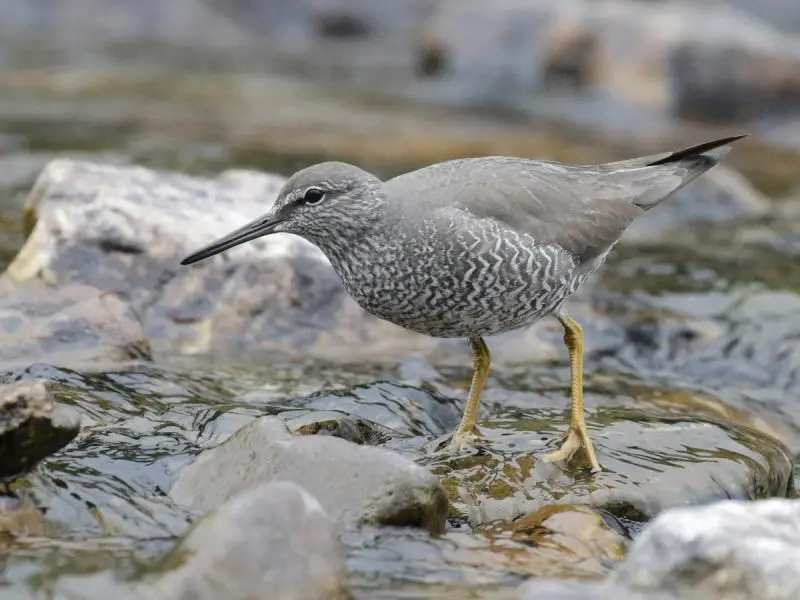
The Wandering Tattler is a medium-sized migratory shorebird that winters in Hawaii after breeding in the mountainous regions of Alaska. It has gray plumage, a pale belly, and a distinctive bobbing motion as it forages along rocky shorelines.
This species is commonly seen on lava rock coasts, tide pools, and coral reefs, where it searches for small crustaceans, insects, and marine worms. Its solitary nature and alert demeanor make it a quiet but consistent presence on the islands’ shorelines.
Wandering Tattlers typically arrive in Hawaii during the fall migration and stay through the winter. When startled, they give a sharp, whistling call while taking flight. Their preference for rugged coastlines sets them apart from other more beach-loving shorebirds.
Ruddy Turnstone (Arenaria interpres)

The Ruddy Turnstone is a small but bold shorebird with striking plumage and a curious behavior—it literally flips over stones and seaweed along the coast to uncover food. Its black-and-white face pattern and orange legs make it easy to identify during its winter stay in Hawaii.
Turnstones are energetic foragers, often seen scurrying across beaches and rocky shorelines. They feed on insects, mollusks, and bits of organic debris washed up by the waves. Their name comes from their feeding style, which is both unique and entertaining to watch.
In Hawaii, these birds are winter migrants and can be found across all the main islands. Though they breed in the Arctic tundra, their presence in tropical islands shows their incredible adaptability and migratory endurance.
Sanderling (Calidris alba)
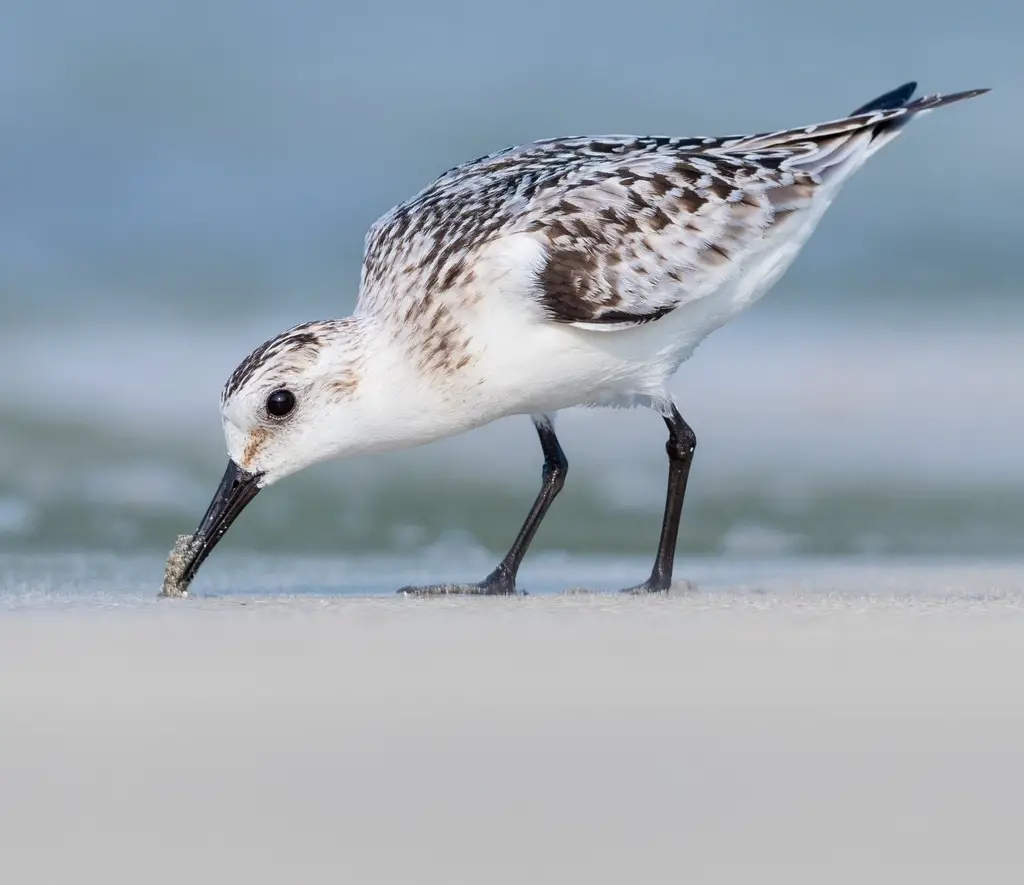
The Sanderling is one of the smallest and most active shorebirds to visit Hawaii in the winter. It’s easily recognized by its pale gray and white coloring and its habit of darting along the edge of the surf, chasing receding waves to catch prey.
These birds feed on small invertebrates buried in wet sand and are constantly in motion. They use their quick legs and probing bills to extract food before the next wave rolls in. Their movements appear synchronized with the rhythm of the sea.
Sanderlings are found on sandy beaches throughout the Hawaiian Islands from fall to spring. Despite their tiny size, they undertake long migratory journeys from the Arctic tundra to the tropics and back each year, showcasing remarkable stamina.
Great Frigatebird (Fregata minor)
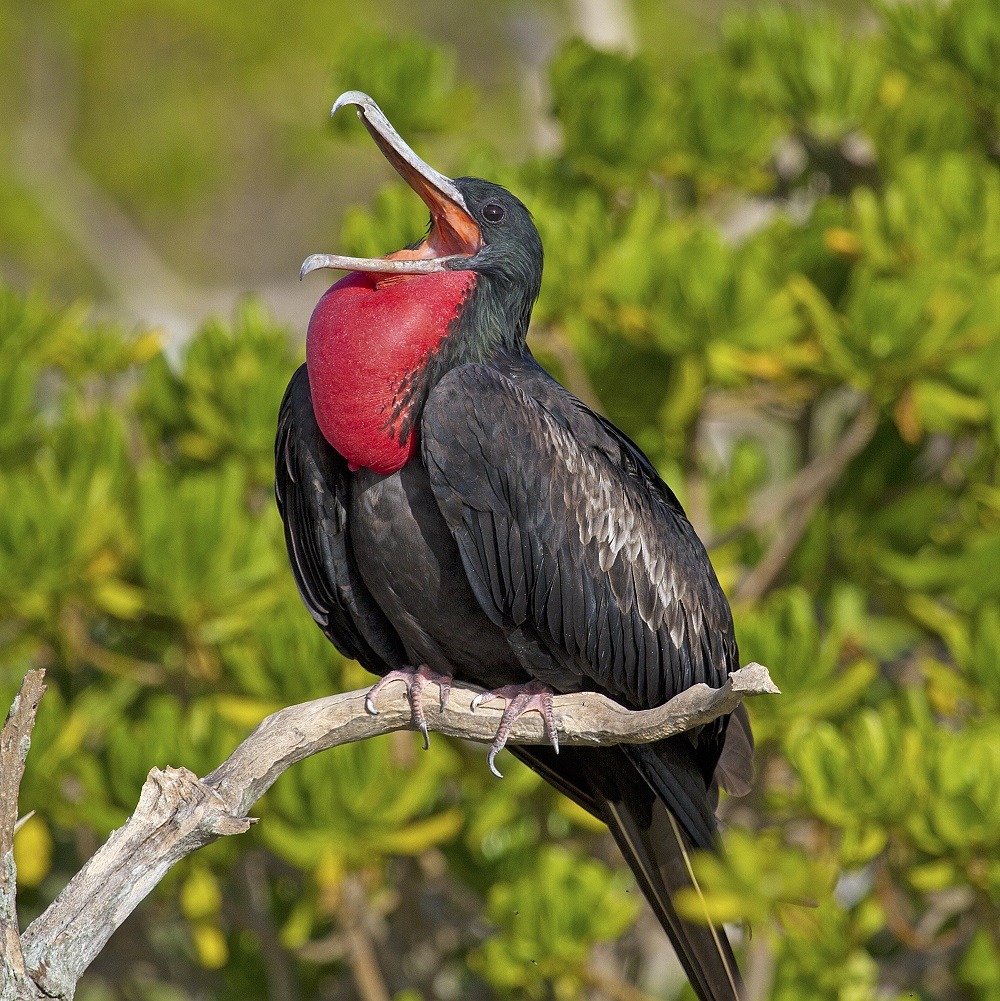
The Great Frigatebird is a majestic seabird with a wingspan that can exceed seven feet, making it one of the most impressive flyers over Hawaiian waters. Males are especially striking during breeding season when they inflate a large red throat pouch to attract females.
These birds are masters of the air, often gliding effortlessly over the ocean for hours without flapping. They feed by snatching fish from the surface or even stealing prey from other seabirds, a behavior known as kleptoparasitism.
Frigatebirds nest in colonies on remote Hawaiian atolls and islands, often in shrubs or low trees. Though rarely seen close to shore on the main islands, they are common sights in the Northwestern Hawaiian Islands and occasionally soar over deep ocean waters near Hawaii.
Red-footed Booby (Sula sula)
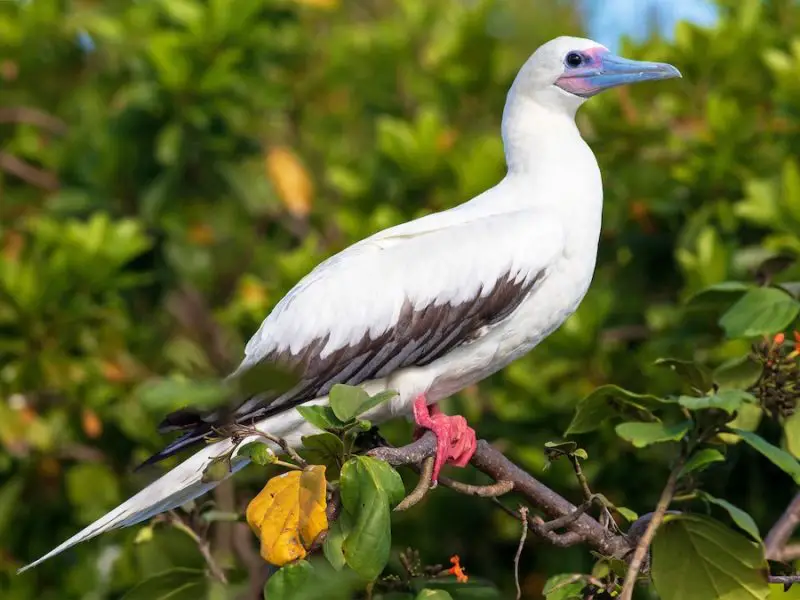
The Red-footed Booby is the smallest of the booby species but among the most colorful, with distinctive red feet, a pale blue bill, and variable plumage ranging from white to gray-brown. These seabirds are strong divers, plunging into the ocean from great heights to catch fish.
Unlike their relatives that nest on the ground, Red-footed Boobies prefer nesting in trees and shrubs, often forming large colonies in coastal areas with good vegetation. They are commonly found on islands like Oʻahu, Lānaʻi, and the Northwestern Hawaiian Islands.
They are social birds and are often seen flying in flocks or perched near their nesting sites. Their agility in both air and water, combined with their vivid features, makes them a favorite among birdwatchers and nature lovers exploring Hawaii’s coastal ecosystems.
Masked Booby (Sula dactylatra)
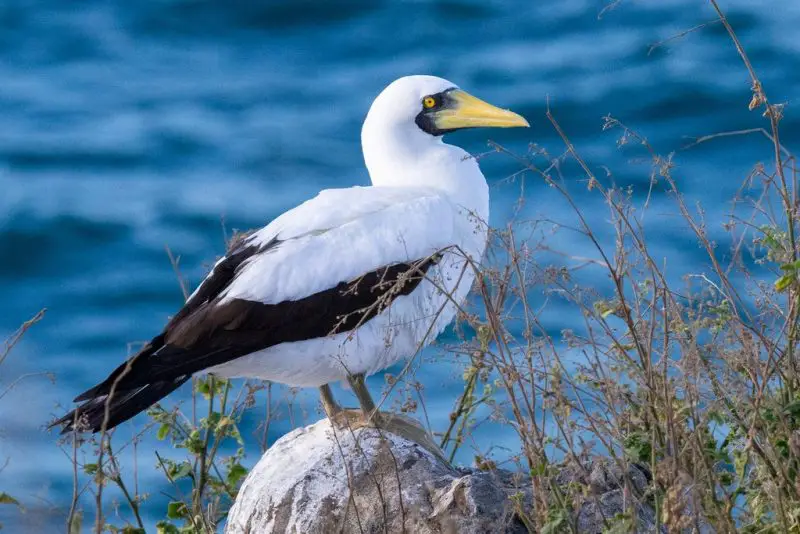
The Masked Booby is the largest of all booby species found in Hawaii. These striking seabirds are named for the bold black markings around their eyes, which give them the appearance of wearing a mask. Adults have brilliant white plumage contrasted by black on the wings and tail, and a yellowish bill that stands out against their face.
Masked Boobies are typically seen nesting and roosting on remote, flat islands such as Laysan and Midway. They prefer open sandy or coral flats where they can take off and land easily, as their large wingspan requires space for flight. Their nests are simple scrapes in the ground, and they usually lay one or two eggs.
As powerful fliers and divers, they soar over the ocean in search of fish and squid, which they catch with high-speed plunges. Though rarely seen near the main Hawaiian Islands, their presence on remote outposts highlights Hawaii’s importance as a breeding ground for pelagic seabirds.
Bridled Tern (Onychoprion anaethetus)
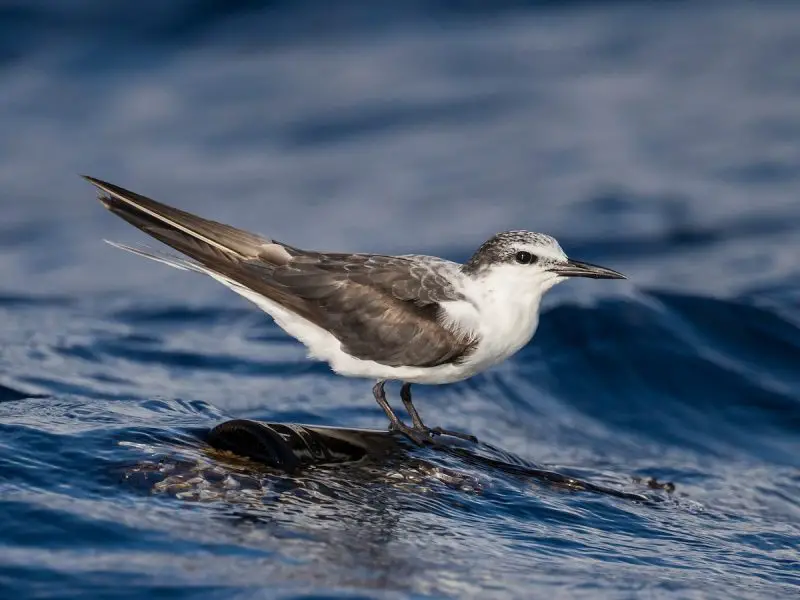
The Bridled Tern is a relatively rare and elegant seabird in Hawaii, recognized by its slender body, gray wings, and black cap bordered by a thin white stripe resembling a “bridle.” Its overall appearance is sleeker and more delicate than many other tern species.
This bird nests in scattered, isolated colonies, often choosing rocky ledges, coastal cliffs, or small islets where human disturbance is minimal. In Hawaii, their breeding sites are limited and carefully monitored due to their scarcity. Unlike more gregarious terns, the Bridled Tern is often quiet and solitary when away from breeding grounds.
Outside the breeding season, Bridled Terns spend much of their lives at sea, gliding over warm tropical waters. Their diet consists mostly of small fish and squid, which they catch with precise mid-air dives. Their elusive nature makes sightings in Hawaii special for avid birdwatchers.

